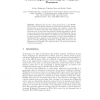JMLR
2002
14 years 3 months ago
2002
Most real-world data is heterogeneous and richly interconnected. Examples include the Web, hypertext, bibliometric data and social networks. In contrast, most statistical learning...
ECIR
2008
Springer
14 years 5 months ago
2008
Springer
Wikipedia is one of the most popular information sources on the Web. The free encyclopedia is densely linked. The link structure in Wikipedia differs from the Web at large: interna...
AIRWEB
2008
Springer
14 years 5 months ago
2008
Springer
Since the link structure of the web is an important element in ranking systems on search engines, web spammers widely use the link structure of the web to increase the rank of the...
ILP
1999
Springer
14 years 8 months ago
1999
Springer
Most real-world data is heterogeneous and richly interconnected. Examples include the Web, hypertext, bibliometric data and social networks. In contrast, most statistical learning...
WADS
2001
Springer
14 years 8 months ago
2001
Springer
Methods for ranking World Wide Web resources according to their position in the link structure of the Web are receiving considerable attention, because they provide the first e�...
WEBI
2005
Springer
14 years 9 months ago
2005
Springer
Beyond serving as online diaries, weblogs have evolved into a complex social structure, one which is in many ways ideal for the study of the propagation of information. As weblog ...
HT
2005
ACM
14 years 9 months ago
2005
ACM
Hyperlinks are an essential feature of the World Wide Web, highly responsible for its success. XLink improves on HTML’s linking capabilities in several ways. In particular, link...
AINA
2007
IEEE
14 years 10 months ago
2007
IEEE
Link analysis is a critical component of current Internet search engines' results ranking software, which determines the ordering of query results returned to the user. The o...
DASFAA
2008
IEEE
14 years 10 months ago
2008
IEEE
Wikipedia has become a huge phenomenon on the WWW. As a corpus for knowledge extraction, it has various impressive characteristics such as a huge amount of articles, live updates, ...
SIGIR
2009
ACM
14 years 10 months ago
2009
ACM
Link analysis methods have been used successfully for knowledge discovery from the link structure of mutually linking entities. Existing link analysis methods have been inherently...




